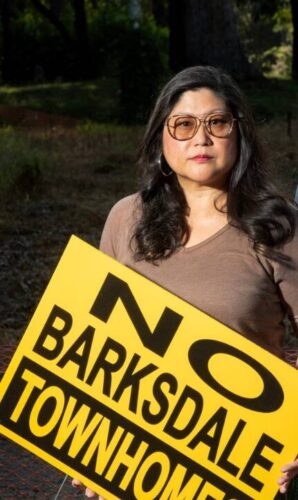
Ann Sun is a kitchen and bath designer and has a B.S. in Interior Design from Meredith College. She has been in residential construction for over 21 years. She’s lived in Raleigh since 1994 and is originally from High Point, NC. Ann has always believed in sustainable and responsible growth for Raleigh’s success.
Ann spoke to City Council on October 15, 2024:
Hello, I’m Ann Sun and I’m 1 of 87 homeowners being sued by a builder in Woodcrest.
This lawsuit is made possible by the City Council which allows major developments without neighborhood input or process and rezoned the missing middle without providing protections in established neighborhoods.
The rezoning ignores scale, proportion, and parking. Our neighborhood ranches are going to be dwarfed by these (12) 41 foot tall townhomes which are 2 ½ times taller than the 18 houses on my street, Barksdale Dr.
Members of the City Council have acknowledged this project is an unintended side effect, a mistake, inappropriate, does not belong in the middle of the street, and some have commented they too would not want to live beside something so large and dense.
We are being forced to live with a City Council mistake: extreme and inappropriate density without consideration for existing homes and families.
Twelve is too many and 41 feet is too tall. Why is there nothing in between?
These townhomes will serve as a constant reminder of when the City Council failed middle class homeowners in an old established neighborhood.
We need the City Council to urgently fix this NOW.
Thank You,
Ann Sun

Daniel McCoy works in Financial Product Sales for FactSet Research Systems, which is based in Connecticut. He recently moved back to Raleigh in 2020 after spending 10 years in New York City. A 2008 graduate from NC State and a born and raised North Carolinian, he always knew Raleigh would be his long-term home. Daniel wants sustainable, gradual growth that protects our neighborhoods and hidden gems to avoid losing the uniqueness of Raleigh.
Daniel spoke to City Council on October 15, 2024:
I live directly across from the proposed Barksdale Development. I think it is lost on many homeowners in Raleigh that what is happening in our neighborhood could happen in yours. There is nothing preventing this type of development based on current law. The Frequent Transit Option includes most of the area inside of 440 and creeps into neighborhoods like ours given the option’s ‘bubble’ extends 0.25 miles beyond a major road (e.g. Capital Blvd, New Bern Ave).
I think Real Estate is Local. Real Estate is best understood locally in terms of the street, surrounding area, elevation changes, and surrounding properties. People purchase and choose to live in areas based on these dynamics and the current legislation removes any consideration for a development across the street from you or next to you. Ann explained this well and anyone who has purchased real estate knows this. We feel that is what is lacking in the current implementation of Missing Middle.
We are asking city council to urgently propose and consider changes to the Frequent Transit Option that allows for a more precise and local
However, the current suggestion is to have a minimum, arbitrary unit limit for these standards to apply. The unit number is suggested to be 12, which I think is still too many considering what Planning has approved on 524 & 528 Barksdale. The developer could simply limit the units to 10 or 11, thus bypassing the regulation. I think the change needs to be relative or a lower unit number so the character of our neighborhoods would not change. The other way is to remove the 0.25 bubble that extends beyond a major road into neighborhoods. There is plenty of land immediately adjacent to Capital Blvd, New Bern Ave and others for developments like the Barksdale Townhome Development.
Thanks,
Daniel McCoy
The images below show the proposed townhomes that would be located between two existing one-story, single-family homes. The contrast is stark.
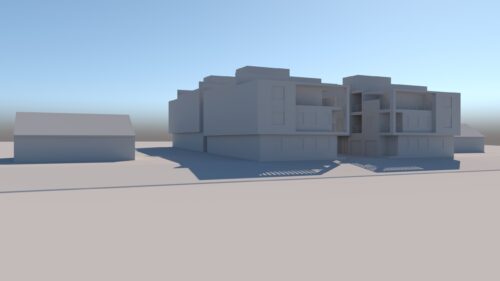
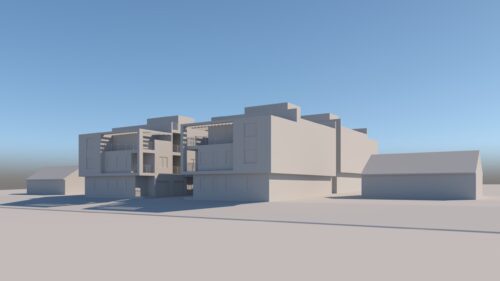
The image below shows hw tightly packed in the 12 townhomes will be in order to fit them on the two single-family lots.
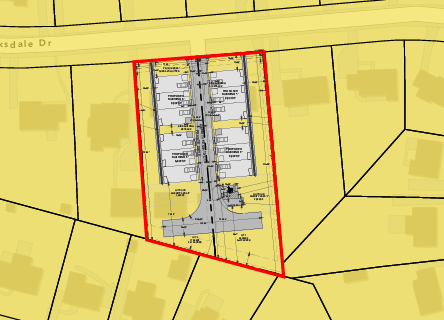
Note from Livable Raleigh: The comments above were delivered to City Council during the Public Comment portion of the meeting. Later during the meeting the council heard a presentation from city staff about possible changes that could be made to the Missing Middle policy. A policy that has made the proposed development Ann Sun and Daniel McCoy talk about possible. Missing Middle was originally sold to the public by the city as “gentle density.” You can see Mayor Baldwin use this description here: What’s Missing from the Missing Middle. Baldwin talks about “Gentle Density” complementing existing homes and infrastructure. You can judge for yourself if you find this proposal to complement the existing homes.
We have written about this before, specifically about how this affects the Woodcrest neighborhood. Missing Middle’s Biggest Mistakes. In this piece, Daniel Parolek, the originator of the term Missing Middle calls this type of development “slot homes,” which are townhomes built perpendicular to the street. He identifies allowing this type of development as the biggest mistake you can make in Missing Middle. The city could correct this “unintended side effect” with a simple change to prohibit slot homes.
At the end of the staff presentation, Mayor Pro Tem Jonathan Melton expressed his thinking about the issue including saying this:
“We cannot stop folks from buying a property and redeveloping it. But, we can encourage folks when they are redeveloping in an existing neighborhood to redevelop in a way that provides a ‘bit more density’ to provide homes for more individuals or families.”
This development cannot in any way be legitimately described as either gentle density or a bit more density.
Replacing two modest single-family homes with twelve 41 foot tall townhomes is a 600% increase in density.
You can listen to Melton’s comment here. The video is cued up to Melton’s remarks:
If you appreciate the kind of reporting we bring to you
|
Please donate $10 or $20, Thanks for supporting |
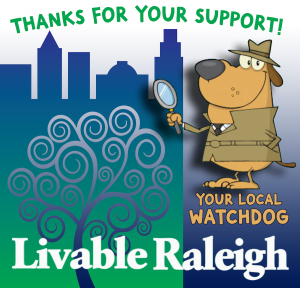 |

